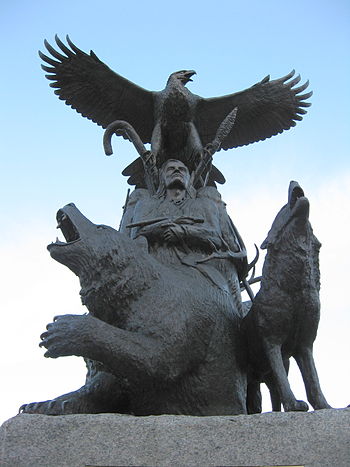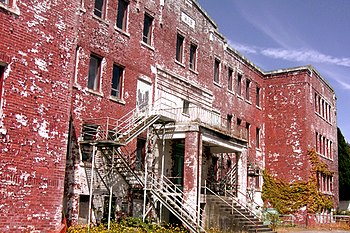 |
| Monument to aboriginal war veterans in Confederation Park, Ottawa, Canada. (Photo credit: Wikipedia) |
 |
| Formerly St. Michael's Residential School Building, Alert Bay. Turned over to 'Namgis First Nation and renamed 'Namgis House in 2003. (Photo credit: Wikipedia) |
 |
| St. Paul's Indian Industrial School, Middlechurch, Manitoba (Photo credit: Wikipedia) |
 |
| Algonquin Couple, an 18th-century watercolor by an unknown artist. Courtesy of the City of Montreal Records Management & Archives, Montreal (Photo credit: Wikipedia) |
I have not yet read the report of the Truth and
Reconciliation Commission on the issue of residential schools. But the reports
about it, and the quoted comments of Judge Murray Sinclair indicate that they
make what seems to me to be the most important point that could emerge: that
is, the residential schools, established as they were to detach native children
from “the barbarous life” of their parents, did not stand alone in the
landscape of government action towards the original inhabitants of this
country.
They were, in fact just one
element of a long-running process, including years of oppressive legislation
passed by our Parliament, whose whole purpose was to detach the original
inhabitants from their land, by, first destroying their economy, and later
destroying everything that meant anything to them --- their beliefs, their
institutions, their world-view, and so on and on.
I could give endless examples of
native groups who had to struggle with this assumption that they were no longer
owners of anything, no longer of any use to anyone, and that their traditional
way of life was a nuisance standing in the way of what the white invaders
called “progress.” I always think back to the Stoneys, displaced by our
declaration of a national park in Banff right in their traditional lands. Their
roaming across their lands living on the animals they could catch and
developing a finely balanced rapport with the nature that surrounded them was
unwelcome to the dominant society, which herded them into small reserves.
Unfortunately, in these reserves they could not feed themselves, so limited
were the resources at their disposal. So the band was placed in the position of
being unwanted outside the reserve, and unwanted inside the reserve, because of
the drain on government through having to provide this proud people, reduced to
poverty and misery, with enough food to keep them alive.
All across the country, similar
stories can be told. The history of the Algonquins, masters of the Ottawa
valley, is very similar. Those living on the Ontario side of the river were
pushed aside to make way for loggers, as the industrial machine began to get
its claws on the country. Of course, they protested, petitioned, year after
year, in a vain effort to get some recognition of their country and their right
to it, but gradually they were gathered together by the religious army of the
assault, and in 1851 Church and State, twin oppressors, combined to set up a large reserve at Maniwaki
into which all Algonquins were intended to be deposited. It didn’t quite work:
the Algonquins who lived in the upper reaches of the river valley --- which
winds its way tortuously across the northern wilderness before descending in a
majestic curve down to join the St Lawrence – these people never went to the
reserve, but continued to live their traditional life in their very own forests.
Of course, that is another story,
as well: the treatment of these Quebec-dwelling Algonquins is another horror
story, as I discovered in the later years of the last century when the people
of Barriere Lake attempted to stop logging companies from cutting their forest
to pieces. Their experience in this regard was so bitter that their community
had been reduced to what must have been one of the poorest in Canada. The catalogue of how governments treated them
traditionally, and of how they have continued to treat them right up to the
present day, is something that should be known --- but isn’t—to every Canadian.
So the bitter experiences of the
residential school were only a part of the treatment meted out to these original
inhabitants of the land, who, when whites first came among them and tried to
stay over their first Canadian winter, had
rallied around the visitors as they neared starvation, and generously saved
them from extinction. A generosity that, looking back on it from a distance,
they might well have come to regret.
What is one of the almost miraculous stories of Canadian history is how these people have survived, how their leaders, generation after generation, have fought the good fight to preserve themselves, against the huge machine of government, courts, and institutionalized racism.
What we Canadians are only slowly
realizing is that as the needs of industrial society are bleeding the lifeblood
out of our living environment, it is these people with their concern for the
health of the land --- they traditionally regard the Land as their Mother ---
who are leading us today in an effort to pull the rampaging machine to a halt,
to preserve the essential life-giving qualities of Nature.
These people we have always
denigrated, we need them, and their concern for the future, more than ever
before.
No comments:
Post a Comment